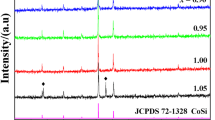Abstract
Current knowledge of the properties of vacancies and the slip behavior and mechanisms of CoSi2 is reviewed based on the results of our recent studies on CoSi2. The concentration of thermal vacancies in CoSi2 is much higher than that in ordinary metals and alloys with melting points comparable with that of CoSi2. Vacancy defects are easily retained in CoSi2 even after air cooling from high temperatures. An annealing stage observed at around 310 K after electron irradiation is concluded to occur by the migration of vacancies to form secondary defects. Peculiar phenomena recently reported on CoSi2 such as an anisotropy of electrical resistivity and the climbing of dislocations at room temperature can be understood on the basis of the current knowledge of defect properties. Slip in CoSi2 occurs along <100> on {001} at low temperatures. The selection of {001}<100> as the primary slip system in CoSi2 can be interpreted in terms of high covalency of Co-Si bonding. a<100> dislocations have a strong tendency to align along their edge orientation and are dissociated into two a / 2<100> partial dislocations separated by a stacking fault on {001}. {001}<100> slip is augmented by {111}<110> and {110}<110> slip at high temperatures. Thermal activation analysis of deformation indicates that while deformation at low temperatures is controlled by the Peierls mechanism, the greatly increased concentration of thermal vacancies influence the mobility of dislocations at high temperatures.
Similar content being viewed by others
References
D.L. Anton and D.M. Shah, in High-Temperature Ordered Intermetallic Alloys III, edited by C.T. Liu, A.I. Taub, N.S. Stoloff and C.C. Koch (Mater. Res. Soc. Proc. 133, Pittsburgh, PA, 1989)p.361.
R.W. Sauer and E.J. Freise, in Anisotropy in Single-Crystal Refractory Compounds, Vol.1, edited by F.W. Vahldiek and S.A. Merson (Plenum, New York, 1968) p.459.
S. Takeuchi, T. Hashimoto and T. Shibuya, in Intermetallic Compounds - Structure and Mechanical Properties-, edited by O. Izumi (Japan Inst. Metals, 1991) p.645; J. Mater. Sci. 27, 1380 (1992).
K. Ito, H. Inui, T. Hirano and M. Yamaguchi, Mater. Sci. Eng. A, 152, 153 (1992).
P. Anongba and S. Steincmann, presented at 1991 Colloque Plastcité at Metz.
K. Suzuki and S. Takeuchi, to be published in Intcrmetallics, 1 (1992).
B.M. Ditchek, J. Cryst. Growth, 69, 207 (1984).
T. Hirano and M. Kaise, J. Appl. Phys., 68, 627 (1990).
D.M. Shah, D. Berczik, D.L. Anton and R. Hecht, Mater. Sci. Eng. A, 155, 45 (1992).
Y. Shirai and M. Yamaguchi, Mater. Sci. Eng. A, 152, 173 (1992).
See for example, J. Takamura, Y. Shirai, K. Furukawa and F. Nakamura, Mater. Sci. Forum, 15–18, 809 (1987).
Y. Ito, Y. Shirai, Y. Yamada and M. Yamaguchi, in this proceedings.
A.G Balogh, L. Bottyan, G. Braucr, I. Dezsi and B. Molnar, J. Phys. F, 16, 1725 (1986).
K. Tanaka, H. Numakura and M. Koiwa, private communication.
A.G. Evans and P.L. Pratt, Phil. Mag., 21, 951 (1970).
T.S. Liu and C.H. Li, J. Appl. Phys., 35, 3325 (1964).
P.E. Irving and C.J. Beevers, J. Mater. Sci., 7, 23 (1972).
K.G. Barraclogh and C.J. Beevers, J. Mater. Sci., 4, 518 (1969).
S. Geller and V.M. Wolontis, Acta Crystallogr., 8, 83 (1955).
Ackowledgments
This work was supported by Grant-in-Aid for Scientific Research on the Priority Area “Intermetallic Compounds as New High Temperature Structural Materials” from the Ministry of Education, Science and Culture, Japan and in part by the research grant from the R & D Institute of Materials and Composites for Future Industries and the NEDO International Joint Research Grant for the Intermetallics Research Team.
Author information
Authors and Affiliations
Rights and permissions
About this article
Cite this article
Yamaguchi, M., Shirai, Y. & Inui, H. Lattice Defects and Plastic Deformation of CoSi2. MRS Online Proceedings Library 288, 131–139 (1992). https://doi.org/10.1557/PROC-288-131
Published:
Issue Date:
DOI: https://doi.org/10.1557/PROC-288-131




